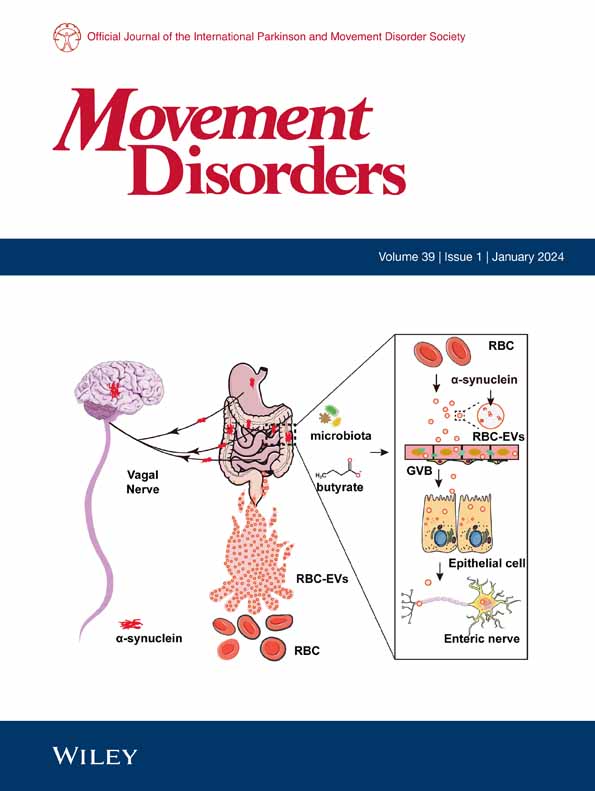神经元α-突触核蛋白疾病分期进展超过5年。
IF 7.4
1区 医学
Q1 CLINICAL NEUROLOGY
引用次数: 0
摘要
神经元α-突触核蛋白疾病(NSD)是由神经元α-突触核蛋白(n-asyn)病理的体内生物标志物的存在来定义的。用于研究的NSD综合分期系统(NSD- iss)将整个疾病连续体的进展描述为0至6期。目的评估早期疾病中NSD-ISS的5年纵向变化。方法分析纳入了2020年之前从帕金森进展标志物计划(PPMI)招募的参与者子集,包括帕金森病(PD)患者、前驱PD患者或符合NSD标准的健康对照(HC)。分期是根据早期n-asyn和多巴胺能功能障碍的生物标志物、临床特征和3至6期功能障碍的严重程度来确定的。每年确定分期,为期5年。结果在576名NSD参与者中,494名PD患者,74名前驱PD患者和8名hc患者入组。基线时,24%的参与者为2B期,56%为3期,13%为4期,其他阶段不到5%。在第5年,2B至4阶段的百分比分别为11%,50%和34%,表明通过NSD阶段的进展。在2B至3期,主要是运动领域的功能损害(95%),在3至4期,非运动功能障碍的程度增加(46%),在4至5期,这些领域的结合推动了进展。在第3阶段,8%的参与者开始服用多巴胺能药物,但在第4阶段,这一比例为41%。我们的分析支持NSD-ISS在确定疾病进展阶段方面的作用,至少在早期临床和前驱阶段(2B、3或4),这表明NSD-ISS作为药物开发的潜在研究工具的价值。涉及临床前队列的进一步研究是至关重要的下一步。©2025作者。Wiley期刊有限责任公司代表国际帕金森和运动障碍学会出版的《运动障碍》。本文章由计算机程序翻译,如有差异,请以英文原文为准。
Neuronal α-Synuclein Disease Stage Progression over 5 Years.
BACKGROUND
Neuronal α-synuclein disease (NSD) is defined by the presence of an in vivo biomarker of neuronal alpha-synuclein (n-asyn) pathology. The NSD integrated staging system (NSD-ISS) for research describes progression across the disease continuum as stages 0 to 6.
OBJECTIVE
The aim was to assess 5-year longitudinal change in NSD-ISS in early disease.
METHODS
Analysis included a subset of participants from the Parkinson's Progression Markers Initiative (PPMI) enrolled before 2020 as Parkinson's disease (PD) patients, prodromal PD patients, or healthy controls (HC) who met NSD criteria. Staging was defined based on biomarkers of n-asyn and dopaminergic dysfunction in early stages, clinical features, and severity of functional impairment in stages 3 to 6. Stages were determined annually for 5 years.
RESULTS
Of 576 NSD participants, 494 were enrolled as PD patients, 74 prodromal PD patients, and 8 HCs. At baseline, 24% of participants were stage 2B, 56% Stage 3, 13% stage 4, and less than 5% in other stages. At year 5, the respective percentages for stages 2B to 4 were 11%, 50%, and 34%, indicating progression through NSD stages. Progression was driven by functional impairment in the predominantly motor domain (95%) for stage 2B to 3, increasing degree of nonmotor dysfunction for stages 3 to 4 (46%), and a combination of domains for stages 4 to 5. Initiation of dopaminergic medications led to stage regression in 8% of participants in Stage 3 but 41% in stage 4.
CONCLUSIONS
Our analysis supports the utility of NSD-ISS in defining the stages of disease progression, at least in the early clinical and prodromal stages (2B, 3, or 4), suggesting the value of NSD-ISS as a potential research tool for drug development. Further research involving preclinical cohorts is a crucial next step. © 2025 The Author(s). Movement Disorders published by Wiley Periodicals LLC on behalf of International Parkinson and Movement Disorder Society.
求助全文
通过发布文献求助,成功后即可免费获取论文全文。
去求助
来源期刊

Movement Disorders
医学-临床神经学
CiteScore
13.30
自引率
8.10%
发文量
371
审稿时长
12 months
期刊介绍:
Movement Disorders publishes a variety of content types including Reviews, Viewpoints, Full Length Articles, Historical Reports, Brief Reports, and Letters. The journal considers original manuscripts on topics related to the diagnosis, therapeutics, pharmacology, biochemistry, physiology, etiology, genetics, and epidemiology of movement disorders. Appropriate topics include Parkinsonism, Chorea, Tremors, Dystonia, Myoclonus, Tics, Tardive Dyskinesia, Spasticity, and Ataxia.
 求助内容:
求助内容: 应助结果提醒方式:
应助结果提醒方式:


